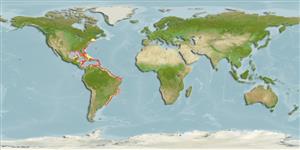Environment: milieu / climate zone / depth range / distribution range
Ecology
Marine; bathydemersal; depth range 87 - 544 m (Ref. 37343), usually 300 - 500 m (Ref. 9626). Deep-water; 46°N - 37°S, 97°W - 32°W (Ref. 57286)
Western Atlantic: Canada (Ref. 5951) North Carolina, the Gulf of Mexico, Caribbean Sea to Uruguay (Ref. 47377) and Brazil (ISH specimens).
Size / Weight / Age
Maturity: Lm ? range ? - ? cm
Max length : 14.4 cm TL male/unsexed; (Ref. 49695); common length : 10.1 cm SL male/unsexed; (Ref. 13608)
Inhabits outer parts of the continental shelves and the upper parts of these slopes (Ref. 37343).
Life cycle and mating behavior
Maturities | Reproduction | Spawnings | Egg(s) | Fecundities | Larvae
Schwarzhans, W.W. and A.M. Prokofiev, 2017. Reappraisal of Synagrops, Günther, 1887 with rehabilitation and revision of Parascombrops Alcock, 1889 including description of seven new species and two new genera (Perciformes: Acropomatidae). Zootaxa 4260(1):1-74. (Ref. 116586)
IUCN Red List Status (Ref. 130435)
Threat to humans
Harmless
Human uses
Tools
Special reports
Download XML
Internet sources
Estimates based on models
Preferred temperature (Ref.
123201): 8.6 - 16.9, mean 11.6 °C (based on 109 cells).
Phylogenetic diversity index (Ref.
82804): PD
50 = 0.5001 [Uniqueness, from 0.5 = low to 2.0 = high].
Bayesian length-weight: a=0.00871 (0.00509 - 0.01490), b=2.98 (2.83 - 3.13), in cm total length, based on LWR estimates for this species & (Sub)family-body (Ref.
93245).
Trophic level (Ref.
69278): 3.5 ±0.5 se; based on size and trophs of closest relatives
Resilience (Ref.
120179): Medium, minimum population doubling time 1.4 - 4.4 years (Assuming tmax>3).
Fishing Vulnerability (Ref.
59153): Low vulnerability (10 of 100).
